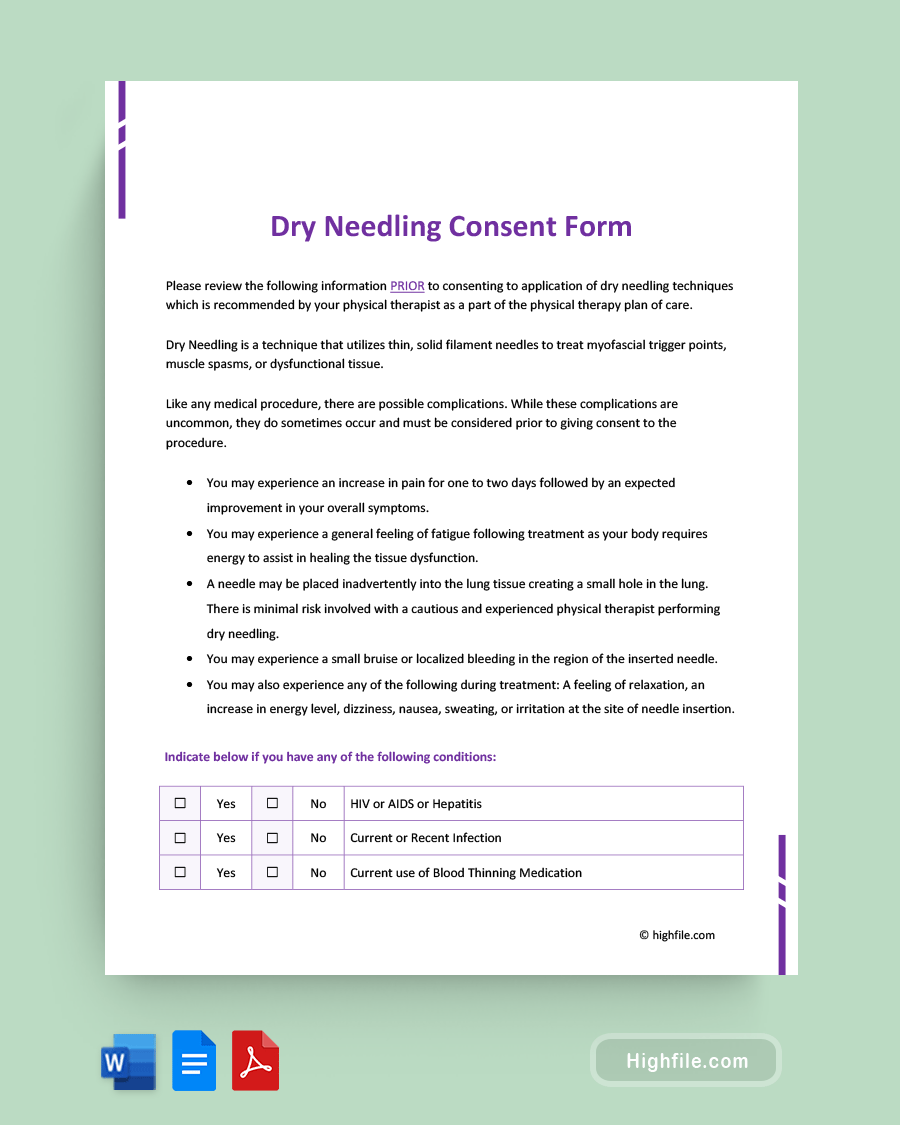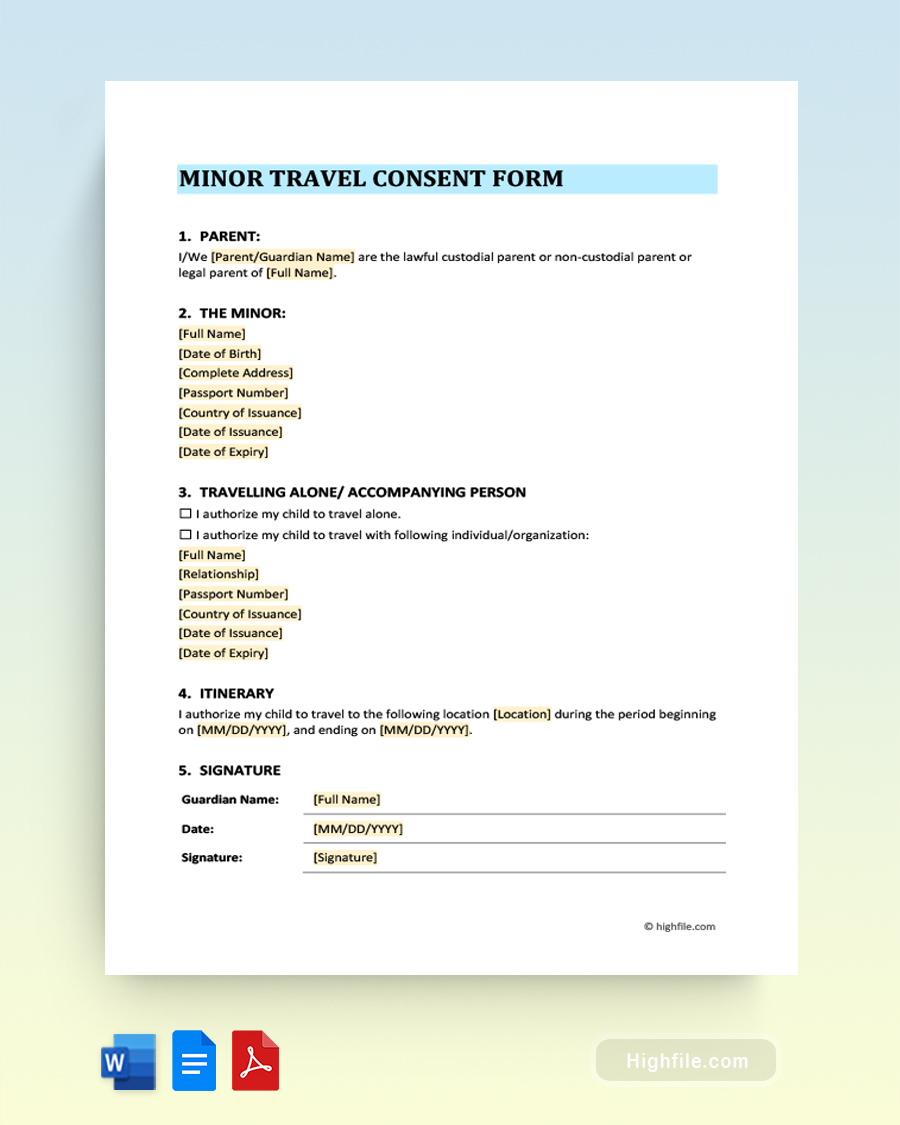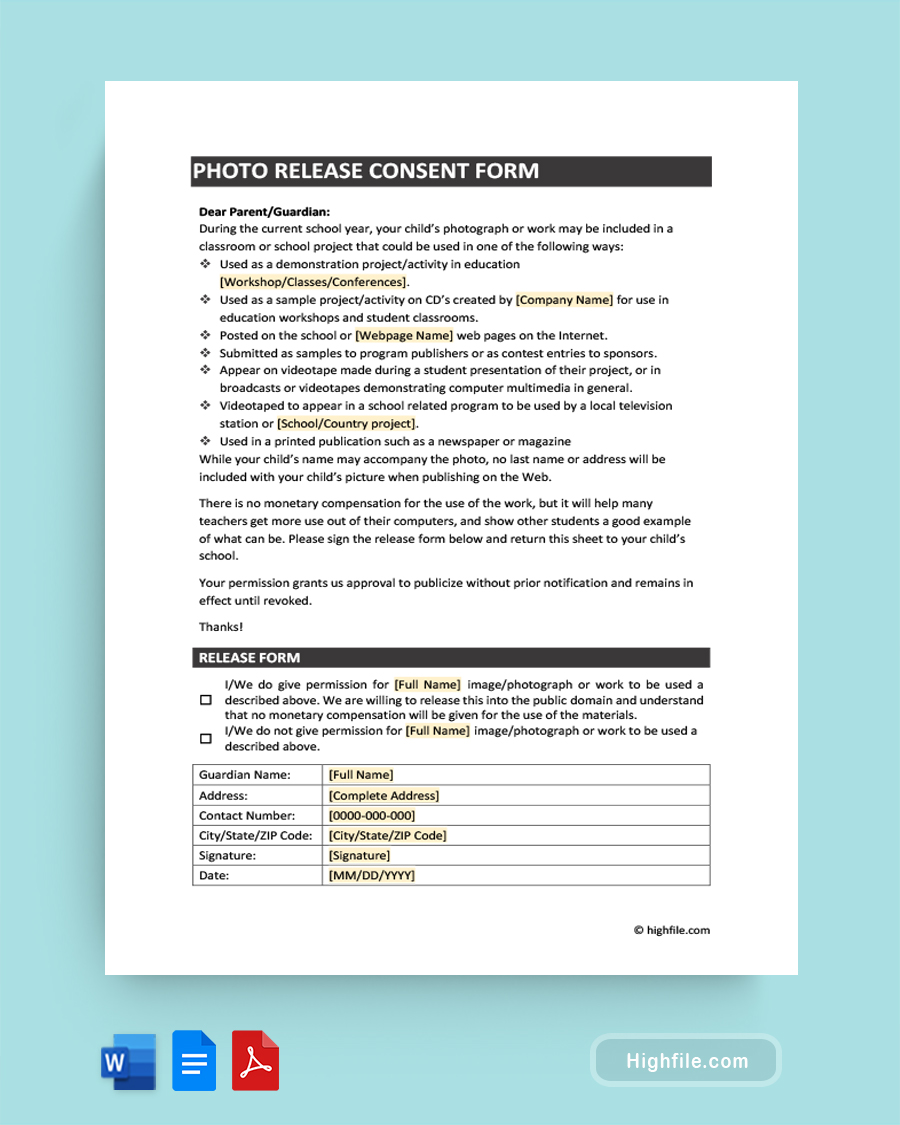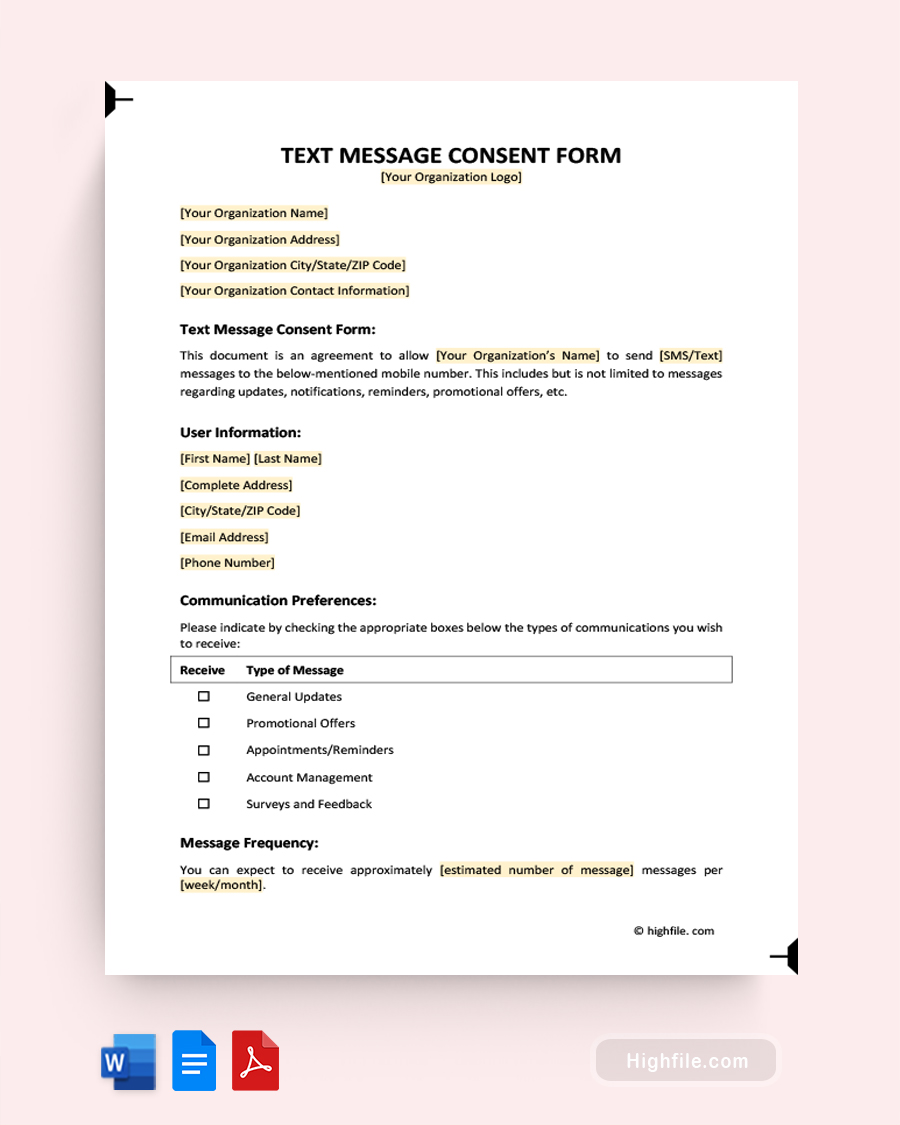Many people seek the services of physical therapists for injuries, joint stiffness, and long-term pain. One of the many services you can offer is dry needling, a technique used to treat pain and improve function and quality of life. However, before your patients can enjoy the benefits of this unique therapy, they must sign a dry needling consent form. These vital documents are similar to other consent forms, except they are tailored to the specific treatment. We strongly recommend using a professionally designed dry needling consent form template to create a complete, custom form for your business efficiently.
What Is a Dry Needling Consent Form?
A dry needling consent form is a legal document that outlines the risks and side effects of dry needling and outlines the agreement between the patient and their care provider. This document also helps protect the therapist and business from litigation and is used to obtain the patient’s consent before the procedure is performed. Patients need to give informed consent for dry needling to ensure that they understand the process, their rights have been respected, they’ve had an opportunity to discuss any questions or concerns, and they freely and voluntarily agree to receive it.
Why Is Dry Needling Consent Form Important?
A dry needling consent form is important because it protects patients and therapists in numerous ways. Below we’ve created a detailed list to explain all the reasons you need these essential forms and why they must have the correct information on them along with the patient’s signature before any treatment occurs.
- Consent forms are required by law before any treatment occurs.
- These documents are part of the mandatory documentation process.
- Consent forms also help show a patient’s medical history to future medical practitioners.
- They respect a patient’s right to bodily autonomy.
- They show that the patient understands the information they’ve been given.
- Consent forms encourage open communication.
- They help promote trust between the therapist and the patient.
- Consent forms help protect therapists and businesses against litigation and liability.
What is the Main Purpose of Dry Needling
The main reason people get dry needling is to experience its numerous health benefits. It can reduce inflammation and pain, improve circulation, and promote relaxation, enabling individuals to regain mobility and function. Dry needling is also known for being a faster and less painful treatment than other forms of therapy. For many people, dry needling offers a viable solution for pain relief without (or in addition to) medication.
Essential Elements of a Dry Needling Consent Form
The essential elements of a dry needling consent form are similar to other medical consent forms. These documents outline the risks and benefits of the procedure, explain how it works briefly, and ask for relevant medical history to ensure the person is a good candidate. Below we’ve laid out an outline of all the essential elements and where they belong on the page.
- (Optional but Recommended) Business Logo or Name- It is standard practice for businesses to use a professionally designed logo or company/practice name at the top of essential documents.
- Title- The title of your form is “Dry Needling Consent Form.” Put this in large bold letters at the top. Doing this shows the reader what this document is for.
- Read Statement- The read statement warns the patient to carefully read the form and consider all the information before signing.
- Process Description- Explain what dry needling is and how it works in a sentence or two.
- Risks and Complications- Here, you’ll list all the risks and possible complications for the patient to review.
- Medical Condition Checklist- Have the patient check a box next to a list of medical conditions that could cause additional complications or risks to the patient or therapist. For example, HIV/AIDS, fear of needles, or blood thinning medications.
- Assent Statement- This is where the patient attests that they have read the information, discussed any questions or concerns, and consented to the terms of the treatment.
- Patient Signature and Date Line- The patient signs or e-signs the form and adds the date of consent here.
- PT Signature and Date Line- The therapist also signs and dates this consent document.
Tips for Making a Better Dry Needling Consent Form
While the essential elements above cover everything you need on your dry needling consent form, the list below aims to improve it. You can upgrade your document in just a few minutes with a little extra effort. Feel free to bookmark this page and come back here for ideas to improve your custom consent form while filling out your template.
- Duration of Session- Provide the patient with an estimate of how long the sessions take.
- Comfort Recommendations- Recommend comfortable clothing, especially if you need to reach areas of the body, such as knees, that are generally covered by clothing.
- What to Bring With You Checklist (for Patients)- If you allow headsets, cell phones, books, or other distraction materials, let the patient know.
- Accessibility and Accommodation- If you offer additional accessibility options, such as a chat and music-free session or rooms with extra space for mobility devices, you can inform patients and list it as a checklist so they can indicate needs or preferences.
- Aftercare Instructions- Explain anything the patient needs to know about post-treatment care.
- How and When to Make Additional Appointments- Give clear directions on how to schedule future appointments.
- Templates- Always use a professional template to save time and ensure the correct information is present.
- Language- Reread your form once complete. Do a spelling and grammar check and look for any complex terminology that may confuse people. It’s best to replace this with easy-to-understand alternatives or provide an explanation of what the terms mean.
FAQs
Dry needling may help patients with pain to feel better. In order to help you answer all your client’s questions, we’ve provided some additional information here on the most frequently asked questions about dry needling. You’ll find data about who makes a good candidate, how long the benefits last, and whether this therapy is clinically proven, among other essential details.
At this time, dry needling is not considered clinically proven. While some clinical trials have been conducted that suggest it can be effective for treating certain conditions such as chronic myofascial pain, peripheral neuropathy, and tendonitis, there is no scientific consensus on its efficacy. However, a fair amount of evidence suggests it helps many patients.
Candidates for dry needling include those with chronic tendonitis or peripheral neuropathy. It can be used to treat musculoskeletal conditions such as headaches, neck pain, and lower back pain. Moreover, this technique is often used for myofascial pain, which originates in muscles and fascia surrounding the body’s internal organs. Muscle spasms, trigger points, and tightness throughout the body typically cause this.
Dry needling is not generally recommended for those with active uncontrolled infections, including but not limited to tuberculosis, active herpes outbreaks, abscesses, or skin infections at the puncture site. Those with a known allergy to any materials used in the procedure should not receive dry needling. It is also not recommended for those using anticoagulants (blood thinners), as this could increase the risk of bruising and/or bleeding at the puncture site. Additionally, those with a history of a bleeding disorder should exercise caution before starting dry needling therapy. Finally, dry needling is not recommended for children younger than 12 years of age, as the effects and safety of this treatment are unknown in this population.
The number of sessions of dry needling needed varies depending on the individual and their condition. Generally, one to three initial sessions of dry needling are recommended, followed by follow-up treatments every two to four weeks. In some cases, fewer or more sessions may be needed to achieve desired results. As part of their treatment protocol, your clinician may incorporate other therapies such as massage, exercise, and stretching to help reduce your symptoms. It is important to discuss an appropriate schedule for dry needling with your clinician to ensure that you get the best possible outcome from the treatment.
Dry needling is a therapeutic technique with multiple benefits. It is typically used to treat tension and muscle spasms. It involves inserting thin needles into the body with the goal of releasing trigger points and any associated muscle pain or discomfort that comes with it. The technique has become increasingly popular in recent years due to its potential to reduce pain without the need for medication. This process is considered invasive, but the needles are very slim and do not usually cause scarring or require healing time. Additionally, there’s no chance the patient will become addicted to dry needling, as is sometimes the case with pain-relieving medications. Unlike medications, patients can have more sessions if necessary without risking their health.
The benefits of dry needling can vary from person to person, but typically the relief is often felt almost instantly after treatment. Short-term benefits can last several weeks and may be improved with multiple sessions. After multiple sessions, some people have reported experiencing long-term relief from their symptoms. Generally, the more severe the condition, the longer the treatment period and the longer lasting the results. However, it’s important to note that these effects are not guaranteed.
Acupuncture is a traditional Chinese medical practice that involves the insertion of thin needles into specific points on the body. These pressure points are thought to be connected to various organs, helping to improve their overall function. By accessing these pressure points, it is believed that energy blockages can be cleared and readjustments can be made, allowing natural energy to flow through the body, reducing pain, and increasing energy levels.
During an acupuncture session, practitioners will assess the patient’s health and their specific needs and discuss any current symptoms or issues. After an assessment, the practitioner will select specific, predetermined points on the body that are deemed suitable. Needles may be manipulated, and sometimes heat or electricity is applied.
Dry needling is a westernized technique that uses thin filiform needles to manually penetrate and stimulate the tissue surrounding muscular trigger points (knots) to promote pain relief and muscle relaxation. It seeks to address both structural imbalances and functional impairments. This technique is designed to improve movement patterns, restore normal function, and reduce pain and stiffness.
Both are effective and share many aspects, such as needle insertion. However, dry needling is a modernized form that is more likely to be performed by a therapist who went to a medical school and received their license from the medical board specific to their state. Meanwhile, an acupuncturist is also licensed and extensively trained, but their federal license and board certifications come from the National Certification Commission for Acupuncture and Oriental Medicine (NCCAOM)
Final Thoughts
Dry needling is a physical therapy treatment involving inserting fine filiform needles into the body’s tissue to reduce pain and help create natural healing processes within the body. Although there is limited empirical evidence regarding its effectiveness, physical therapists have increasingly used dry needling to treat soft tissue and neuromuscular disorders. Since this therapy is performed by medical practitioners, like any other medical treatment, patients must sign a consent form. When you use a dry needling consent form template, it offers a structured format that will save you time and help create a complete, professional document you can reuse as many times as you like.







